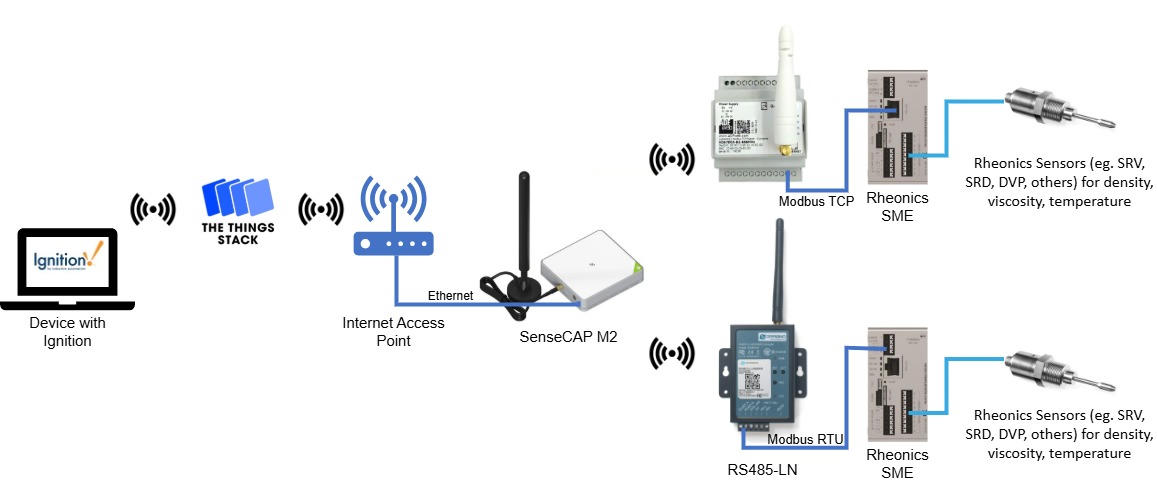TABLE OF CONTENTS
- 1. What is LoRaWAN?
- 2. LoRaWAN Characteristics
- 3. LoRaWAN components
- 4. LoRaWAN Connection
- 5. LoRaWAN messages
- 6. LoRaWAN Classes
- 7. LoRaWAN Regions specification
- 8. LoRaWAN Network Servers
- 9. LoRaWAN applications
- 10. References
1. What is LoRaWAN?
LoRaWAN stands for Low Power, Wide Area Network. It is a communication protocol that allows devices to connect to the internet wirelessly [1]. LoRaWAN is the software layer that defines how devices use LoRa, which is the technique that encodes information on radio waves using chirp pulses, making it robust against interference [2].
2. LoRaWAN Characteristics
- Useful for transmitting small-sized payloads like Rheonics sensor data over long distances (up to 10km)[3].
- Low power consumption.
- AES-128 encryption ensures secure communication.
- Bidirectional communication, which means the devices can send and receive data.
3. LoRaWAN components
- End devices: devices that send or receive messages via a gateway.
- Gateways: intermediary that connects end devices with the network server via the internet.
- Network Server: software that manages the LoRaWAN network.
- Application servers: responsible for processing and visualizing the data.
![Figure 1: LoRaWAN architecture [4]](https://s3-ap-south-1.amazonaws.com/ind-cdn.freshdesk.com/data/helpdesk/attachments/production/81180881083/original/wj5iRs1o9pQ-7GlAbtujRXCW0AQ0sdvm9g.png?1763140852)
Figure 1: LoRaWAN architecture [4]
4. LoRaWAN Connection
For end devices to communicate, they must be registered on a LoRaWAN network server [5]. There are two activation methods: OTAA and ABP.
4.1. Over The Air Activation (OTAA)
It is a secure and recommended activation method. It consists of a join procedure with the network, where security keys are generated.
Prior to activation
3 main variables should be defined in the end device and Network Server to make the connection.
- AppEUI (JoinEUI): provided by the device or can be randomly generated in the network, and is used to identify the Join Server, which assists during the join procedure.
- DevEUI: unique identifier of the device, typically assigned by the manufacturer.
- AppKey: secret key that should be used by the network where the end device will register.
Procedure
- End device sends a join-request to the network.
- The network verifies the request and generates session keys (AppSKey and NwkSKey) if the device is allowed to join.
- The network server sends a join-accept message back to the device.
- Network server keeps the NwkSKey previously generated and sends the AppSkey to the application server.
- End device decrypts the join-accept message and gets the two session keys (AppSKey and NwkSKey), and now it is activated.
![Figure 2: LoRaWAN OTAA procedure [5]](https://s3-ap-south-1.amazonaws.com/ind-cdn.freshdesk.com/data/helpdesk/attachments/production/81180881098/original/brk116nTXcpvISpXUBLvmOEiLesaneYdLQ.png?1763140924)
Figure 2: LoRaWAN OTAA procedure [5]
4.2. Activation By Personalization
It is a simpler but less secure activation method.
Procedure
- DevAddr, NwkSKey, and AppSKey are stored on the end device.
- DevAddr and NwkSkey are also stored in the network server.
- AppSKey is stored in the application server.
5. LoRaWAN messages
- Uplink messages: sent by the end device to the network server through a gateway.
- Downlink messages: sent by the network server to an end device through a gateway.
End devices can't send uplink messages while receiving downlink messages.
6. LoRaWAN Classes
LoRaWAN has different device types, which determine the communication [6].
- Class A: sends uplink messages at any time
- Class B: receives periodic downlink messages. Low latency for downlink
- Class C: can receive downlink messages at almost any time. Lowest latency, but highest power consumption.
7. LoRaWAN Regions specification
LoRaWAN allows users to use unlicensed radio frequencies, which makes it a low-cost option. These frequencies enable long-range communication, and for this reason, specific bands are assigned to different regions according to regulations. The frequency plans can be found at Frequency Plans. To check the regional parameters depending on the country, refer to RP002-1.0.4 Regional Parameters. In countries without a specified LoRaWAN plan, it is possible to use end devices or gateways that follow another regional channel plan.
8. LoRaWAN Network Servers
As mentioned before, network servers are necessary to manage messages and connections. Some of the most widely used are:
- The Things Network (TTN)
- ThingPark (Actility)
- Helium
- Senra
- Swisscom
- ChirpStack
9. LoRaWAN applications
1. Remote Monitoring
Send sensor data to a gateway and visualize it through a LoRaWAN network server remotely.
2. Integration with AWS
AWS IoT Core for LoRaWAN provides a managed LoRaWAN Network Server, enabling direct integration of device data into AWS services.
3. Integration with MQTT
The Things Network server has the option to work as an MQTT server, which can be connected to Ignition to receive data and visualize it remotely.

Figure 3: Integration of LoRaWAN with Ignition
To configure the SenseCAP M2 LoRaWAN gateway refer to the following article Configuring LoRaWAN Gateway for Remote Data Visualization of Rheonics SensorsTo use a LoRaWAN/Modbus TCP Master Converter for Remote Data Visualization of Rheonics Sensors refer to Using LoRaWAN/Modbus TCP Master Converter for Remote Data Visualization of Rheonics SensorsTo use a LoRaWAN/RS485 Converter for Remote Data Visualization of Rheonics Sensors refer to Using RS485-LN LoRaWAN Converter for Rheonics Sensors Remote Data Visualization
10. References
[1] What is LoRaWAN® Specification
[2] What are LoRa and LoRaWAN?
[3] Understanding LoRaWAN Fundamentals
[6] Device Classes
